OCTOBER 1, 1921 Centre-Clemson / Harvard-Holy Cross
Centre was to open against Clemson at home on Saturday, October 1. The old wooden stadium had been spruced up as best possible while the team prepared for the Tigers. Ticket sales were so strong that the athletic department again conducted a crash program to try to add more seats, since many of the temporary seats from the previous years had to be dismantled due to safety concerns. Crews managed to get enough built that the capacity of the old lady was just a bit over 6,000 if you counted standing-room fans.
Clemson was coming off a 4-6-1 season. The 4 victories were over the weaker teams on the schedule- Erskine, Newberry, Wofford, and The Citadel.
Presbyterian and Clemson tied, 7-7.
Auburn, Tennessee, South Carolina, Georgia, Furman and Georgia Tech all beat the Tigers, but as has been pointed out, and as the Centre players were constantly reminded, "Boys, this team got beaten by Georgia Tech, 7-0. They played Tech evenly. You know what happened to us against Tech."
An article appeared under the headline, "Clemson Confidant of Trouncing Centre," in a Charleston, South Carolina paper on September 28. A summary of the article was telegraphed to the Chief, and it was tacked onto a bulletin board in the dressing room so all of the Colonels could read it.
Uncle Charlie managed to get released from his umpiring duties a few days early and arrived in Danville on Tuesday morning, September 28. His arrival had been publicized in both Danville papers and in chapel. He was met by many of the faculty, every member of the team, and most of the students, all of whom gave a lusty cheer when he stepped off the train, a big smile on his face.
Amongst Uncle Charlie's baggage which was transported to the Gilcher Hotel was a canvas bag containing several wooden-shafted golf clubs. The Centre mentor had decided to take up golf at age 42, and later said that any free time he had on the baseball circuit, he hit the links.
"I hit the links. I didn't say I hit the ball!"
After settling in at the Gilcher, Uncle Charlie headed to the campus. The "Messenger" reported that:
"... the newcomers thought a cyclone had hit the field. Unc slipped into his moleskins shortly after noon and trotted out onto Cheek Field with all of the pep of a two-year old. Danville is mighty glad to welcome him home and believes another "Wonder Team" will be turned out in the fall. "
( The term "moleskins" was often used to signify a football uniform. It was understood to mean a heavy-napped, cotton twill fabric, often used to make clothing, especially trousers.)
There were but 3 practice days before the opening game with Clemson.
In Cambridge, Coach Fisher and his staff were preparing for the Holy Cross game. With the double-header under their belts, the Crimson players knew they had a much greater challenge than had been presented the previous week.
Holy Cross was a Jesuit college founded in 1843, situated in Worchester, Massachusetts, 25 miles west of Boston. The "Crusaders," an appropriate name for a Catholic school, first played Harvard in 1904, and then 3 straight years, 1911-13. Harvard won all 4 of those contests by a combined score of 102-12.
The previous year's 1920 game proved to be a tougher affair than the earlier contests. Holy Cross was playing good football and Harvard won by a field goal, 3-0. Holy Cross went on to defeat an excellent Syracuse team later that year.
With many of the starters returning from the 1920 squad, Holy Cross expected to give the Crimson all they could handle, and did. Once again, Harvard eked out a 3-0 win on a field goal by quarterback, Charles Buell.
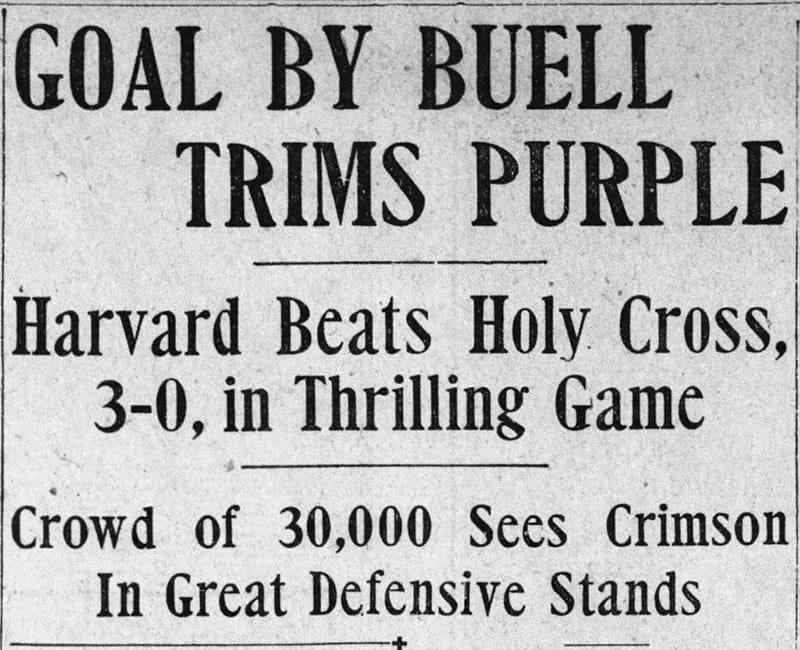
Even though his team won, Coach Bob Fisher was dissatisfied with his offense, and particularly with the line play. Changes were expected in the starters when practice took place the following Monday.
Uncle Charlie had the luxury of devoting his full time to the backfield now that he had the assistance of Tiny Thornhill. Tiny was pleased at the skill and toughness of the freshmen who had come to Centre. Ed Kubale was a spectacular talent and would fill the center slot for the foreseeable future. Bill Shadoan would eventually more than adequately replace Sully Montgomery. Minos Gordy, the "Cajun" from Abbeville, Louisiana, looked good in practice, as did "Buck" Jones, the 213 pounder from Dallas.
Centre had a scare during practice when Bo was hit in the nose. Uncle Charlie reached into his bag of tricks and devised a nose-guard of sorts.
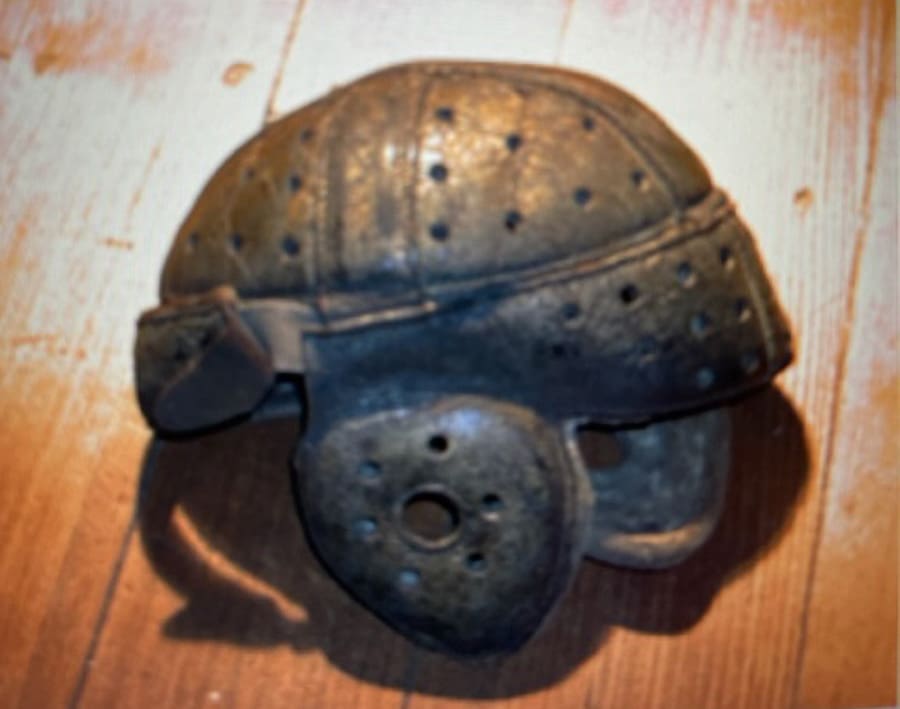
Bo's actual helmet
( Noseguards on football helmets first began to appear in the mid-1920's. The first was often a single metal bar, and over the years they evolved into a very effective protective device, becoming mandatory in 1939. The introduction of the face mask necessitated that a new penalty be added to the game- 5 yards for unintentionally or accidentally grabbing a mask, and 15 yards if the infraction were to be intentional or flagrant.)
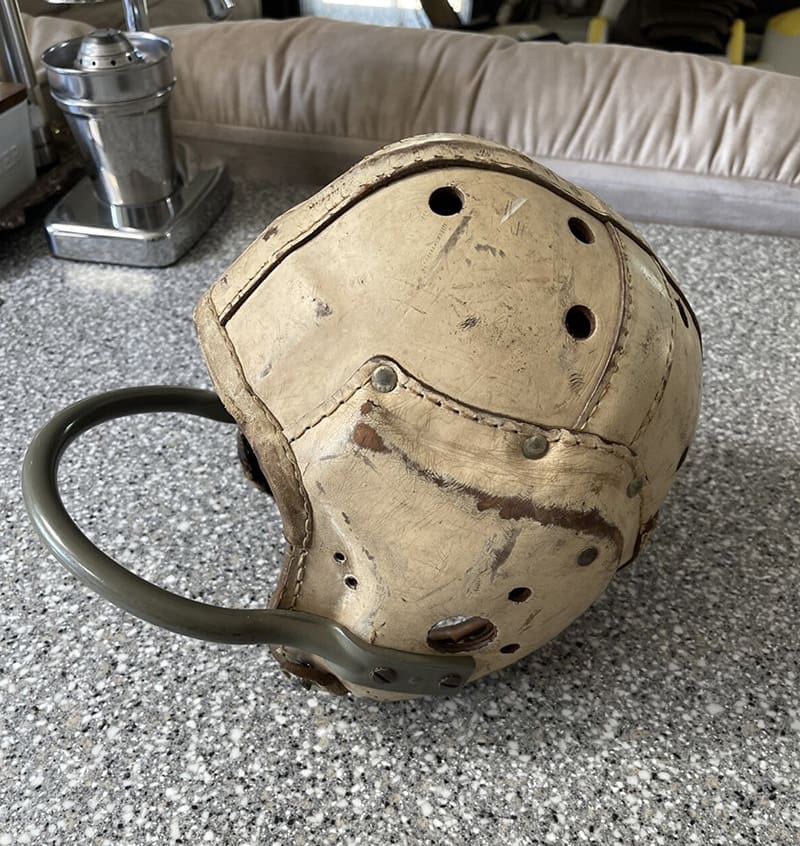
Early helmet with rudimentary faceguard
George Swinebroad led a spirited pep rally in chapel on Friday morning, Centre held a non-contact workout that afternoon, and the Colonels were ready to open the 1921 season on Saturday, October 1. Clemson had taken an overnight Pullman to Lexington, leaving Wednesday afternoon. They disembarked and spent Thursday in Lexington, working out during a closed-door session on Kentucky's Stoll Field. On Friday, the Tigers journeyed on the Southern to Danville and had another private workout on Cheek Field in Danville.
Clemson was coached by E.J. "Doc" Stewart who was head coach at Oregon State during 1913-15, going 15-5-5. Stewart went to Nebraska during 1916-17 and compiled an 11-4 record before his career was interrupted by the War.
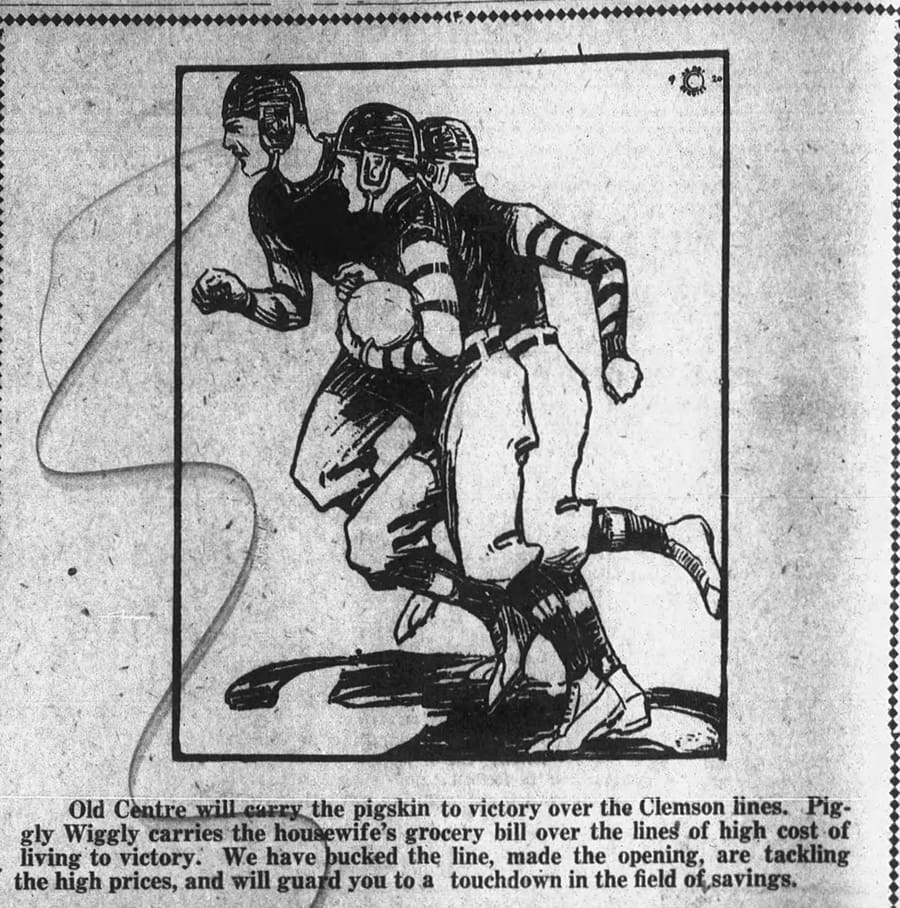
Piggy Wiggly, a grocery chain with a Danville location, makes a prediction and analogy
Over 6,000 fans came to the October 1 game. They watched a very workmanlike effort by the Colonels. Uncle Charlie had Bo run a very conservative game plan. He and Tiny Thornhill were mainly concerned with making certain that the Colonels could play defensively with an intensity which could win against Harvard.
Bo and Army had said, "We know we have the offense to score against anybody. What we want to do this season is to shut out every opponent."
It was an ambitious goal. Not only the players, but the Centre coaches felt it was achievable.
Centre lead 7-0 at the half after the Colonels put together a sustained drive late in the second quarter. Clemson had to punt and Bo called out a play from his own 35 and Hump Tanner went over right tackle for 20, Bo skirted around his left end for 12, and it was first down on the Tigers' 33.
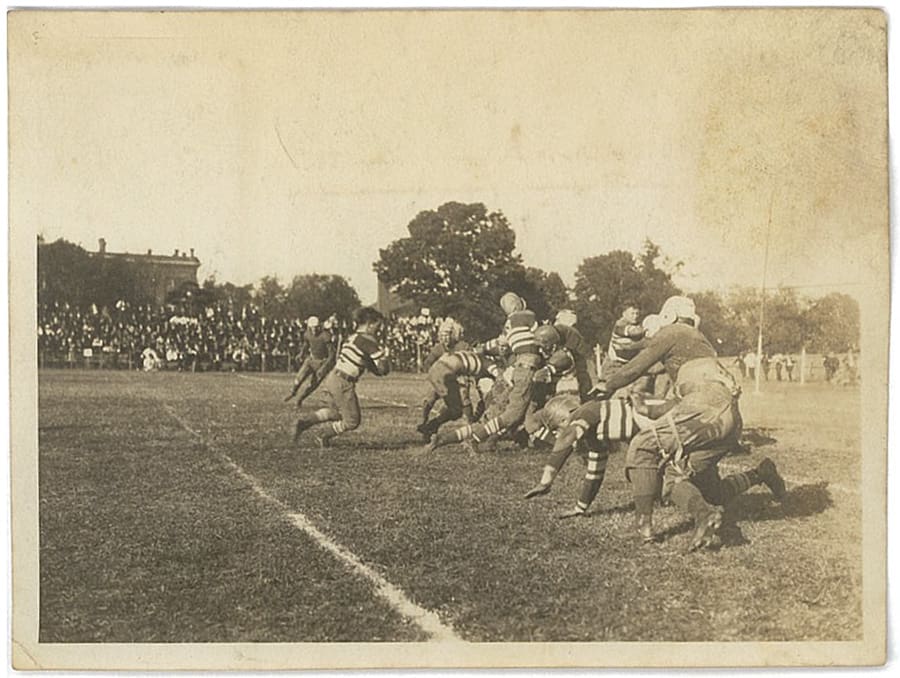
Hump Tanner ( 4 ) running against Clemson. Red Roberts, without helmet, can be seen blocking in background
The game had been rather unspectacular to that point, but the Centre partisans sensed that their team was on the move and cheered them on, wanting to take the lead going into the locker room for the halftime break.
Army got 3, Tom Bartlett plunged ahead for 5, and Bo picked up the first down when he went around the left side for 10.
The ball was on the Clemson 15. Hump was brought down after picking up 3. Tom Bartlett burst through and went 12 yards for the first score of 1921. Bartlett's extra point was the 100th straight. Red Weaver didn't get it, but Centre did.
During the third quarter, Centre picked up another score, set up by a Terry Snowday interception.
Bo picked up 9. Uncle Charlie had sent in Minos Gordy at fullback and he picked up a first down, going 6. Centre confused Clemson with a cross-buck play as Bartlett gained 15. A 15-yard penalty gave the Colonels the ball on the 18. Bo swept around the right end as his line pulled out and led the way, totally clearing the Clemson defenders out. He scored untouched, and Tom Bartlett kicked to make the final margin 14-0.
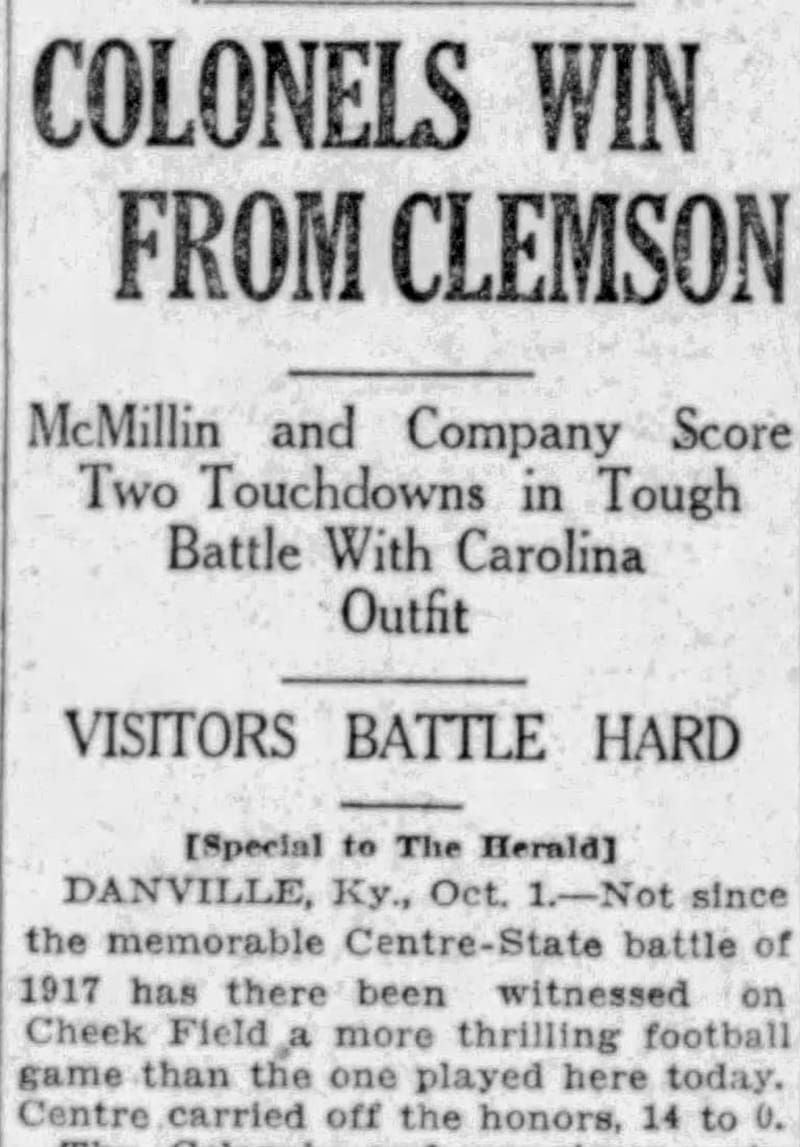
Centre played 23 men. Uncle Charlie just didn't play 23 men in a relatively close contest!
Bo had been quoted- "You had to nearly get killed to have a substitute sent in." 1921 was going to be different. Centre had been outmanned against Harvard in 1920 as Coach Fisher was able to substitute frequently and effectively.
"It won't happen again," was the vow that the Colonels' coaches had made as the season began. They were determined to have the depth to play at Harvard's level. The games preceding the trip to the East were designed to develop the depth which would be needed.
"We don't intend to run up any big scores early in the season. We will win, we feel confidant of that. But we will also give our men game experience, as much as necessary, to have them ready for Harvard."
It was Harvard. It was always- Harvard.
Centre played 9 of the 19 freshmen against Clemson. Tiny Thornhill felt confident about his line. Uncle Charlie felt that same level of confidence about his backfield.
With Bo, Army, Hump Tanner, Tom Bartlett, Chick Murphy, Hennie Lemon, Herb Covington, Tom Moran, and Red Roberts if needed, Centre could just keep rotating backs in all afternoon without losing one bit of speed or skill. They were tough. They played intelligently. Each of the backs at Centre could play for any team in the country. The little school had the greatest collection of backfield talent of any team in the country in 1921.
Terry Snowday, and Case Thomasson were all excellent ends. Hennie Lemon could also play end, and later in his career, that was his best position. George Chinn was hopefully going to contribute if he recovered adequately from the injury which he had during the 1920 Harvard game.
( Chinn never was able to play in 1921 even though he continued as a member of the team. )
Bill James was back for his 5th year at tackle. Ben "Baldy" Cregor had filled out to a solid 180 and was a 4th year man. The freshmen in the line were skilled and had size.
There simply wasn't any weakness on the Centre team of 1921.
